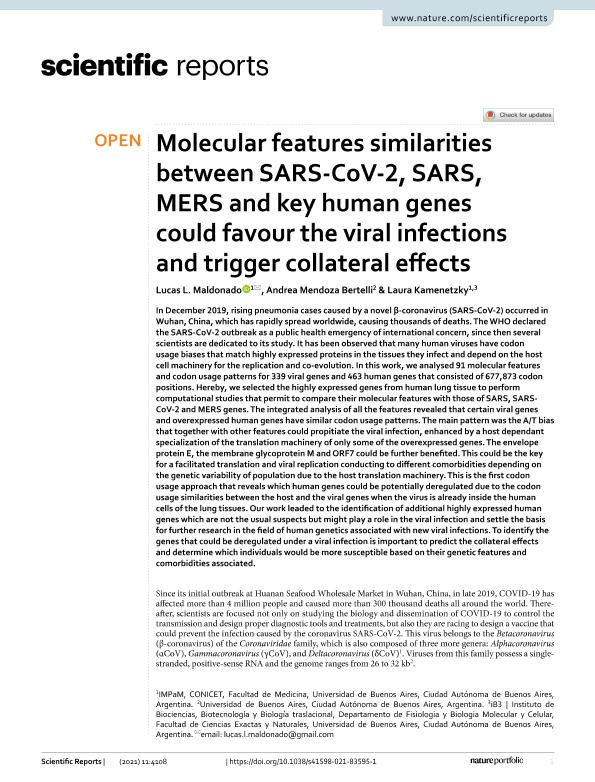Mostrar el registro sencillo del ítem
dc.contributor.author
Maldonado, Lucas Luciano

dc.contributor.author
Mendoza Bertelli, Andrea Cristina

dc.contributor.author
Kamenetzky, Laura

dc.date.available
2021-03-03T19:34:07Z
dc.date.issued
2020-02-18
dc.identifier.citation
Maldonado, Lucas Luciano; Mendoza Bertelli, Andrea Cristina; Kamenetzky, Laura; Molecular features similarities between SARS-CoV-2, SARS, MERS and key human genes could favour the viral infections and trigger collateral effects; Nature Research; Scientific Reports; 11; 4108; 18-2-2020; 1-17
dc.identifier.issn
2045-2322
dc.identifier.uri
http://hdl.handle.net/11336/127345
dc.description.abstract
In December 2019, rising pneumonia cases caused by a novel β-coronavirus (SARS-CoV-2) occurred in Wuhan, China, which has rapidly spread worldwide, causing thousands of deaths. The WHO declared the SARS-CoV-2 outbreak as a public health emergency of international concern, since then several scientists are dedicated to its study. It has been observed that many human viruses have codon usage biases that match highly expressed proteins in the tissues they infect and depend on the host cell machinery for the replication and co-evolution. In this work, we analysed 91 molecular features and codon usage patterns for 339 viral genes and 463 human genes that consisted of 677,873 codon positions. Hereby, we selected the highly expressed genes from human lung tissue to perform computational studies that permit to compare their molecular features with those of SARS, SARS-CoV-2 and MERS genes. The integrated analysis of all the features revealed that certain viral genes and overexpressed human genes have similar codon usage patterns. The main pattern was the A/T bias that together with other features could propitiate the viral infection, enhanced by a host dependant specialization of the translation machinery of only some of the overexpressed genes. The envelope protein E, the membrane glycoprotein M and ORF7 could be further benefited. This could be the key for a facilitated translation and viral replication conducting to different comorbidities depending on the genetic variability of population due to the host translation machinery. This is the first codon usage approach that reveals which human genes could be potentially deregulated due to the codon usage similarities between the host and the viral genes when the virus is already inside the human cells of the lung tissues. Our work leaded to the identification of additional highly expressed human genes which are not the usual suspects but might play a role in the viral infection and settle the basis for further research in the field of human genetics associated with new viral infections. To identify the genes that could be deregulated under a viral infection is important to predict the collateral effects and determine which individuals would be more susceptible based on their genetic features and comorbidities associated.
dc.format
application/pdf
dc.language.iso
eng
dc.publisher
Nature Research
dc.rights
info:eu-repo/semantics/openAccess
dc.rights.uri
https://creativecommons.org/licenses/by-nc-sa/2.5/ar/
dc.subject
SARS-CoV-2, SARS, MERS
dc.subject
CODON USAGE
dc.subject
VIRAL GENES
dc.subject
COVID-19
dc.subject.classification
Virología

dc.subject.classification
Ciencias Biológicas

dc.subject.classification
CIENCIAS NATURALES Y EXACTAS

dc.title
Molecular features similarities between SARS-CoV-2, SARS, MERS and key human genes could favour the viral infections and trigger collateral effects
dc.type
info:eu-repo/semantics/article
dc.type
info:ar-repo/semantics/artículo
dc.type
info:eu-repo/semantics/publishedVersion
dc.date.updated
2021-03-02T15:16:48Z
dc.journal.volume
11
dc.journal.number
4108
dc.journal.pagination
1-17
dc.journal.pais
Reino Unido

dc.description.fil
Fil: Maldonado, Lucas Luciano. Consejo Nacional de Investigaciones Científicas y Técnicas. Oficina de Coordinación Administrativa Houssay. Instituto de Investigaciones en Microbiología y Parasitología Médica. Universidad de Buenos Aires. Facultad de Medicina. Instituto de Investigaciones en Microbiología y Parasitología Médica; Argentina
dc.description.fil
Fil: Mendoza Bertelli, Andrea Cristina. Consejo Nacional de Investigaciones Científicas y Técnicas. Oficina de Coordinación Administrativa Houssay. Instituto de Investigaciones en Microbiología y Parasitología Médica. Universidad de Buenos Aires. Facultad de Medicina. Instituto de Investigaciones en Microbiología y Parasitología Médica; Argentina
dc.description.fil
Fil: Kamenetzky, Laura. Consejo Nacional de Investigaciones Científicas y Técnicas. Oficina de Coordinación Administrativa Houssay. Instituto de Investigaciones en Microbiología y Parasitología Médica. Universidad de Buenos Aires. Facultad de Medicina. Instituto de Investigaciones en Microbiología y Parasitología Médica; Argentina. Universidad de Buenos Aires. Facultad de Ciencias Exactas y Naturales. Instituto de Biociencias, Biotecnología y Biología Traslacional; Argentina
dc.journal.title
Scientific Reports
dc.relation.alternativeid
info:eu-repo/semantics/altIdentifier/doi/http://dx.doi.org/10.1038/s41598-021-83595-1
dc.relation.alternativeid
info:eu-repo/semantics/altIdentifier/url/https://www.nature.com/articles/s41598-021-83595-1
Archivos asociados
